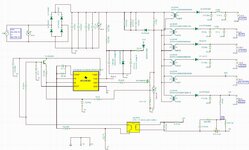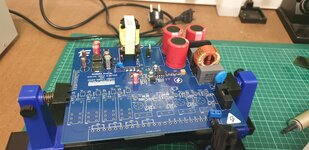abdo.medo1000
Member level 1
Hi
I have designed a switched mode power supply circuit using UCC28C42 IC, the circuit should work with wide range input of 40 -350 DC. The circuit have multiple outputs (24v, 10v, -10, 5v and 3.3v). I have manufactured and custom transformer with thesis parameters from local manufacturers.
I have tested the whole circuit on TINA TI, and it is working very well with different voltage input from 40 DC till 350v DC, but when I made the PCB of the circuit and tested it on the lab.
The problem is the output of 5v and 3.3v are changing when the applied input voltage is low.
I have tested the circuit with these values:
As you see on the table above when applying voltage lower than 300v the value of output 3.3v and 5v is decreasing but the voltage values of 10v and -10v seem stable.
Why this problem is happening, why some voltage outputs are decreasing, and the other are not ?
I will use 3.3v and 5v to feed my STM32 MP1 MPU, STM32f4 MCU and ARTIX 7 FPGA for that I want to have steady voltage for them what do you recommend for me as a solution?
Is using a Linear Voltage Regulator a good option?
I am looking forward for your answer
I have designed a switched mode power supply circuit using UCC28C42 IC, the circuit should work with wide range input of 40 -350 DC. The circuit have multiple outputs (24v, 10v, -10, 5v and 3.3v). I have manufactured and custom transformer with thesis parameters from local manufacturers.
I have tested the whole circuit on TINA TI, and it is working very well with different voltage input from 40 DC till 350v DC, but when I made the PCB of the circuit and tested it on the lab.
The problem is the output of 5v and 3.3v are changing when the applied input voltage is low.
I have tested the circuit with these values:
| Input | output of 3.3v | output of 5v | output of 10v | output of -10v |
| 220 AC (after the bridge rectifiers is 310 DC) | 3.8v DC | 5.5v DC | 10.3v DC | -10.8v DC |
| 65v DC | 2.0v DC | 3.1v DC | 10v DC | -10v DC |
| 51v DC | 1.9v DC | 2.6v DC | 9.9v DC | -10.5 DC |
| 131 DC | 2.4v DC | 3.7v DC | 9.8v DC | -10.5 DC |
As you see on the table above when applying voltage lower than 300v the value of output 3.3v and 5v is decreasing but the voltage values of 10v and -10v seem stable.
Why this problem is happening, why some voltage outputs are decreasing, and the other are not ?
I will use 3.3v and 5v to feed my STM32 MP1 MPU, STM32f4 MCU and ARTIX 7 FPGA for that I want to have steady voltage for them what do you recommend for me as a solution?
Is using a Linear Voltage Regulator a good option?
I am looking forward for your answer

